There was a time when the Climbing Narc ruled over the climbing blogosphere with an iron fist. Well, maybe a foam cheese fist. Like some great flatland Oz, his real identity remained behind the curtain for most of us, adding a hint of mystery to what was going on over there in Milwaukee.
If you didn’t divine his real identity slowly through posts a number of years ago, you certainly know the Narc’s face now. Brian Runnells, 31, has weaved his way from online kingpin to the face of Louder Than 11’s live competition broadcasts and talk shows. All while juggling full-time work as a web developer, a lovely wife and a possibly unhealthy infatuation with rock climbing.
Thundercling reached out to Brian for some dish on where he’s at in life right now. Through bouts of laughter (Brian has the humor of a British wise ass), we chatted about the origins of both his climbing life and the Narc website, the anti-glamour of running a popular climbing blog, the vast differences between the Midwest and Boulder, Co, the shifting state of climbing media, the effects of social media on our little climber brains and what it feels like to go live on camera in front of a nation of eager climbing wingnuts.
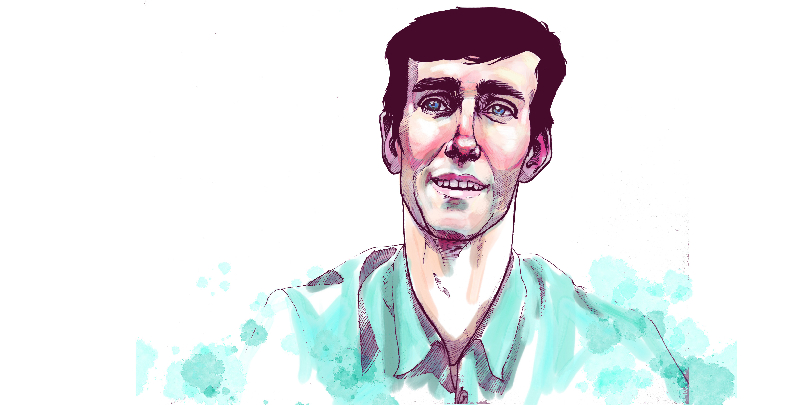
Original artwork by Lynn Suyeko Mandziuk.
Thundercling: So, I’m sitting outside the Loony Bean [in Bishop, CA], I got my computer with the questions going, a digital recorder on my lap and my phone synched through the radio system.
Brian Runnells: Oh, wow…
TC: It’s pretty ridiculous. How ya been?
BR: Pretty good. How are things on the road? I think I actually saw you when I was in Joe’s Valley. I saw your camping set up.
TC: Yeah, we were on the Right Fork next to the Warm Up Boulder. How was your trip?
BR: It was good. It was pretty quick and it rained the second day, so we didn’t get to climb a ton. But, it was a fun time.
TC: Hey, what’s your standing with Louder Than 11? Do you have an official title over there?
BR: No, it’s all unofficial. I guess I just work with them on all the broadcasts that they do. It’s kind of fun how things have changed.
TC: How was that first time?
BR: I don’t really remember too much about it. I’m sure I was really nervous. I don’t think I’ve ever watched it so I don’t really remember much about it.
TC: It’s always good not to watch or listen to that stuff. The sound of your own voice is always so shockingly awful.
BR: Yeah, it’s hard.
TC: “Do I really talk out of my nose?” Okay, let’s start the interview…
TC: I’ve read that your interest in climbing was piqued after reading “Into Thin Air.”
BR: So, we read it in high school English class – I think it was junior year – and because how we were going through the book I ended up reading it two or three times in the course of the class. I’d always been into the outdoors but being in Wisconsin, there’s no mountains anywhere, so it kind of never occurred to me that I might be interested in those kinds of things until I read the book. After that I went to a local gear shop in Milwaukee that turned out was closed. But next door was a climbing gym so I went to the climbing gym instead and that’s when I started climbing.
TC: Did you have any friends that you dragged along with you into it?
BR: No. None of the friends I had before I started climbing ever took up climbing.
TC: You never even got an extra harness for them and dragged them out for a test run?
BR: I think I’ve taken all of my friends to the gym maybe once or twice at the most, but none of them have ever gotten into it.
TC: We have a similar story because you know I’m from Iowa. I was working at a sporting goods store and they had, for whatever reason, Masters of Stone on. I saw Fred Nicole doing a pinkie pull-up and I was like, “Oh my god, I want to do that.” One month later I’d saved up money and bought everything and took all of my friends out. But, the thing is, slowly but surely, they gave it the old college try for two months and then they were like, “This sucks. I’d rather play baseball or pick-up basketball.”
BR: Yeah, the problem with climbing is that it’s not very fun that first time out. For me it was really hard and I don’t remember why I kept doing it. I wasn’t very strong and I didn’t feel very coordinated when I was climbing but there was something about it that just clicked.
TC: I think that first experience for everybody is fairly similar. Especially if you’re a flatlander like us, it is so foreign. Some of us, for whatever reason, find that little shred of awesomeness in it and if we’re lucky we get to grow it.
BR: Yeah, I’d always been into climbing trees and stuff as a kid so I think that probably was part of it.
TC: And just an innate sense of adventure. You have that weird gene… Describe the road that took you to Colorado, in conjunction with your love of climbing.
BR: I started climbing in high school. When I graduated high school I went to Colorado and Wyoming for a road trip and obviously had a great time. That’s what planted the seed for me wanting to move out to Colorado. Unfortunately, right after that I went to school in Madison for four and a half years and that kind of derailed the plan. Then, real life things kept me in Wisconsin for a lot longer than I thought they would. I got married after college, got a job, got a house and all that stuff. Just never left.
TC: Were you taking road trips at that time around the country?
BR: We would go climbing mostly in the Southeast but I never went back to Colorado, for I think seven years, after the first time. I don’t really know why that was. I think part of the reason was that during college I got hurt a lot so I didn’t go climbing as much and traveling was harder. Once I got out of school we just started sport climbing a lot down in Kentucky.
TC: And you climbed a lot in Devil’s Lake, too.
BR: Yeah. I definitely have done all kinds of stuff up there, bouldering and rope climbing.
TC: I learned how to trad climb at Devil’s Lake and that’s the strangest place to learn because you’ll never climb like that anywhere else.
BR: That’s true…that’s the only place I’ve really ever trad climbed, outside of a couple trips to Yosemite. Devil’s Lake is pretty unique.
TC: It’s like climbing on glass. You know, nice crimps for your hands and then, like, road runnering your feet. That’s what I remember back in the day.
BR: I did a lot of campusing on vertical walls there. And I actually learned how to sport climb in Iowa, of all places.
TC: At Wild Iowa?
BR: Yup. That’s the first place I ever sport climbed. I’ve probably been there five or six times.
TC: That’s where I learned to climb, too. That place isn’t so bad, for what it is.
BR: Yeah, it’s a cool little spot. I had a lot of fun there. I think the hard thing is that when I started climbing, climbing in the Red really wasn’t as much of a thing as it became a few years later. 2000, I think, was the first time I went to Wild Iowa.
TC: I just took my girlfriend there [in June] and she thinks it’s the worst place ever.
BR: I mean…it probably is. I think there’s a certain Midwest nostalgia about going there if you went there early on in your climbing.
TC: I agree. It’ll always be home. It will always be the dilapidated, almost-foreclosed home that I want to go back and see… When you moved to Boulder, what were some of the main differences you noticed right away after leaving the Midwest?
BR: Honestly, the main difference – climbing-wise – between Boulder and most places is the sheer number of climbers there are. People are way stronger. If you can climb V7 in Wisconsin then you’re kind of a big deal. In Boulder, that’s how people warm up. It’s not just a few people, not just professional climbers. Everybody is way better.
TC: What about the social scene?
BR: The social scene in Boulder is pretty weird. Since I’m married it’s fun for me to watch from the sidelines. It seems like there’s a lot of dating drama that goes on, which is kind of unique to here…but maybe it isn’t. For me, I found it to be a lot nicer… A lot of people like to make fun of Boulder and say it’s not a nice place to come and it’s not a good environment. I found everyone here to be super-friendly and a lot of fun to climb with.
TC: I heard that, too. And I agree with you; I think everybody there is [pretty nice]. I mean, you definitely have some egos but everyplace has some egos. Why do you think Boulder gets nailed with that moniker so often?
BR: I don’t know. I think a lot of it is what you want to make of it. So, if you want to get embroiled in petty social beefs with people, you can do that easily here. But, if you just want to be more grown up about things, it’s pretty easy to do that, too.
I think there are a lot of people’s situations in Boulder that are not normal. It’s kind of a joke here that nobody seems to work and that seems to be sort of true with some people. So, it’s not necessarily real life for a lot of these people.
TC: It certainly seems that way. I think it’s easy for outsiders to see all of the fun and all of the climbing success that people have and it can make people feel embittered towards Boulder.
BR: Yeah, I know. I would definitely feel embittered if I didn’t live here. I would. I was. And if I move away from here I’ll probably still be bitter.
TC: So, injuries. Climbers are often injured, but your injuries have been climbing news for years now. And you’ve had a lot of them. What kinds of injuries have you sustained in the last decade?
BR: Well, at the start I had most of the normal climber injuries; finger tweaks, elbow problems, shoulder problems. I’ve had those on and off for 15 years, basically, since I started climbing. At least once or twice a year I’ll have one of those. I’ve also sprained my knees heel hooking at least three or four times now so I couldn’t climb for six to eight weeks. I’ve ruptured a tendon in my ankle standing on a hold…I don’t understand why. That was definitely the most major one. I didn’t walk for four months after that without some kind of assistance.
TC: I can’t believe you blew your knees on heel hooks. That seems odd.
BR: Yeah, I did that again just this past August when I was heel hooking. I think my joints are really flexible so if I’m putting a ton of pressure on the outside of my knee it just gives out. I’ve done that four times now, so I should probably stop doing those kinds of moves.
TC: What are your symptoms when you do that to your knee?
BR: It sounds like I break a hold on whatever climb I’m on. It’s like a really loud pop followed by a lot of cursing. The last time it happened I was in Upper Chaos in Rocky Mountain National Park. It was my birthday so I was extra unhappy. There was whiskey, at least…
TC: What do you attribute all the injuries to? Just “try hard?”
BR: Probably 50 percent mental and 50 percent not taking care of myself the way that I probably should to prevent some of these things from happening. I know that my knees are weak and I should try to strengthen them in some way…but I would rather go climbing.
TC: Do you train at all?
BR: I guess you could call what I do, sometimes, “training.” A lot of the times I just go climbing. This year I had a project I was working on so I tried to train as much as I could, in between injuries. I hurt my knee in August but still managed to climb my project in October, but I couldn’t climb for a few weeks in there.
TC: Was your project Whispers of Wisdom?
BR: It was, yeah.
TC: Congrats. What a great send.
BR: Thanks. Yeah, definitely a highlight.
TC: Let’s move on to the Climbing Narc. When did the site get off the ground? You started in 2007, is that right?
BR: Yeah, in February of 2007.
TC: I initially noticed a lot of posts about your climbing trips in the Midwest and then a golden age where you were the best aggregate site in the States, and finally I’ve noticed a bit of a wane on the site (I mean, you posted 14 times alone in November, and that’s still a boatload). Talk about the evolution of the site.
BR: So, the evolution of the site has been a natural progression as to whatever I’m doing at the time. I should say that overall, there really has never been a grand plan. I thought of it and started it in the same day. I just did what I wanted with it, which is post about whatever I found interesting. People seemed to react to that, which was awesome. Which is why the posts about what I was doing started tapering off over the years because I found that people weren’t as interested in those.
It’s just hard to believe how long it’s gone on. It’s going to be eight years coming up. And I found in the last couple years as my responsibilities in other areas have gone up my ability to work on the site has gone down because it really is time consuming to do the volume that I was doing for probably four or five years consistently. It was hours a day trying to look through stuff and write the posts.
TC: I guess what I want to get at is inside the headspace you had when you were posting in 2009 and 2010 and 2011. I mean, you were the first site I went to every day and I think many climbers would say the same thing. You just seemed super psyched.
BR: I think a lot of it is like this feedback cycle where the traffic on the site was going up every month so I kept wanting to feed into that. The more I posted the more traffic the site got and that really drove me to keep working hard on the site.
TC: Do you think that as you progressed as a climber, as well, your interest in the site took a back seat to your personal climbing?
BR: I think there’s definitely something to that. Working on the site is not very good for my climbing because it’s not what I need to worry about with my climbing, it’s more worrying about what other people are doing and spending time focused on that. And, of course, throughout that time I was injured for various stretches. I had a lot more time to work on the site. It’s kind of ironic that when I moved to Colorado five years ago, I thought that would have been great for the site but it’s actually been the opposite. I spend so much more time doing things outside here I just don’t have as much time for the site. Not to mention that it costs a lot of money to live here so I have to work more than I used to.
TC: But the site is in no danger of going down?
BR: I don’t really know how to answer that because since I’ve never really had any long term plans set aside it’s hard to know what I’m going to do with it in six months or a year.
TC: Why do you think so many people identified with Climbing Narc?
BR: That’s a good question. I don’t really know how people found the site as it started. I didn’t know anybody in the climbing industry. [I wasn’t] friends with a famous climber that could promote the site for me or anything like that. I don’t think there’s any one thing that has made it popular with people but I feel like people kind of identify with the passion I have with climbing. That really comes through in what I do. And, that I don’t take it so seriously all the time. It’s just a way to have fun with climbing when we’re not out doing it.
TC: One thing that was cool about the site was that there was some dude in Wisconsin helming a big blog news site…no one even knew your name. That mystery was kind of enticing.
BR: I don’t think I really associated my name with the site for a number of years for whatever reason. Probably, I was just embarrassed about how much I cared about some of this stuff. That’s funny moving out here because it’s become kind of awkward to write about people that you see at the gym all the time. I’m not friends with them but I know them and it’s kind of a weird situation in that respect.
TC: In 2011, Outside magazine awarded you the best climbing blog, edging out Andrew Bisharat’s “Evening Sends,” Steph Davis’s “High Places” and even Deadpoint Magazine’s site. Talk about how that made you feel. Did you ever feel any pushback that what most would call an aggregation site took that honor?
BR: At first I was confused. I was sort of cynical and thought they wanted me to post about it or something to give them traffic. I’m just kind of wired that way. I never felt the site was that big of a deal so I would never have put my site ahead of a number of ones that were on that list. Obviously, it was cool to be recognized that way but I never really put a ton of stock into it. I didn’t let it go to my head, I guess I would say.
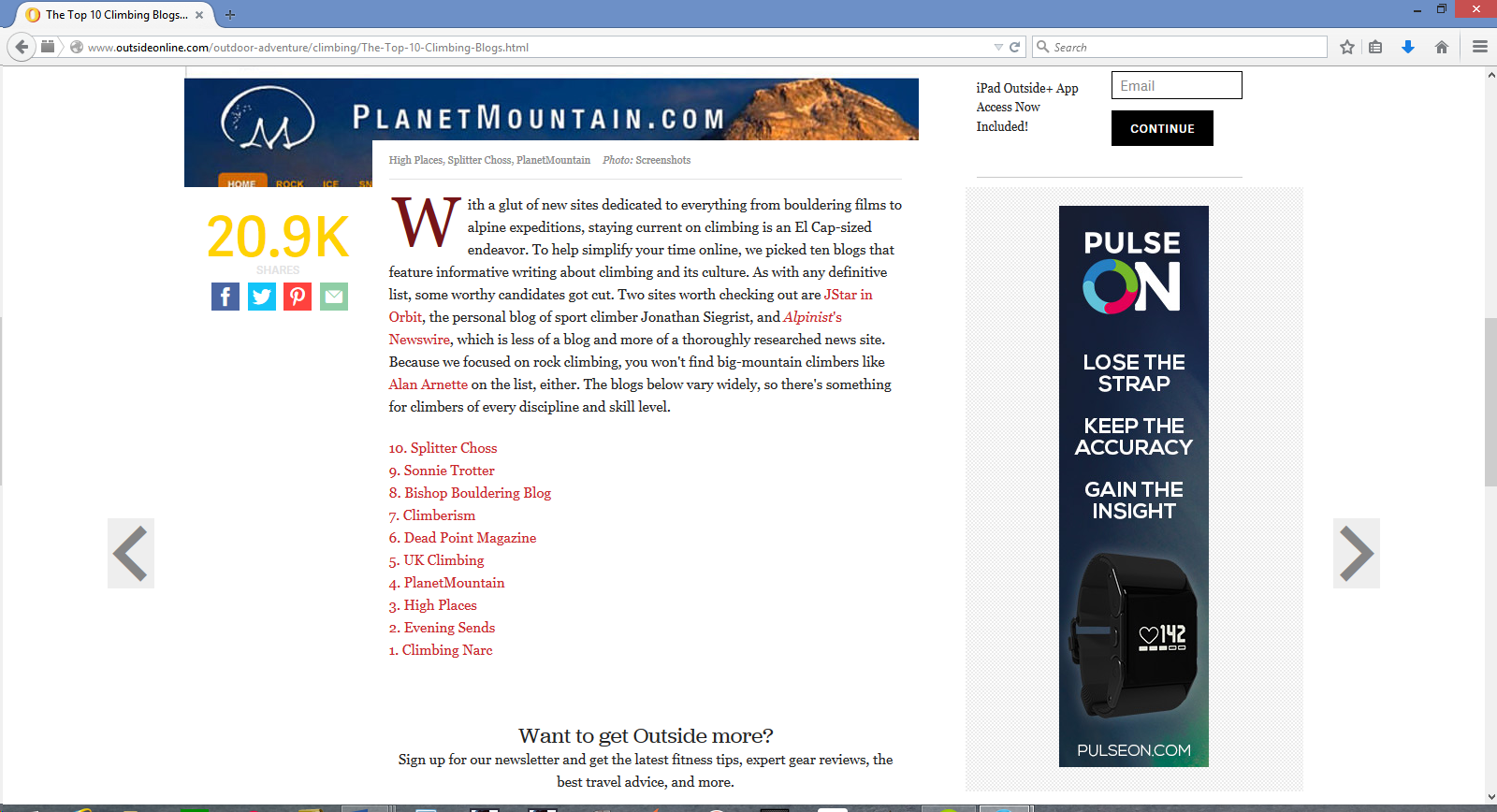
TC: You know what’s weird? They’ve never done that since.
BR: Yeah. I’m not really sure what the deal was with them. I think it was that one of the editors there at the time really cared about climbing blogs. I think he left after that.
TC: Actually, they fired him after that article. So, do you think the Climbing Narc is an aggregator site or would you call it something else entirely?
BR: I don’t really know what label I would apply to it. I never really thought of it that way but I’ve seen a lot of people put it in that light, sometimes positively and sometimes negatively. I always try to approach it as I’m trying to share things that I’m interested in that other people might be interested in. That’s where the whole site started. You know, I saw all these interesting things happening in climbing and there was no good way to sort of share them under one roof, so to speak. As a consumer of climbing media myself I was just tired of going all over the place to find things. So, I thought if I could bring them together in one location it might be helpful. It turned out that it was.
TC: There was a time, a couple of years ago, where a lot of jabber was going on about blogs and internet sites watering down climbing media. It was a question, I think, of perceived quality; that the blogs were offering shit while the mags were struggling reaching people with what they would have called quality media, and I agree that it was and still is high quality. We’ve all seen magazines struggling, across the media board. The shuttering of Urban Climber, the total retooling of Climbing Magazine. How do you think internet sites and free media have affected the mags and do you have any predictions for the future of both online and print climbing media?
BR: Well, I think it’s the same in climbing as it has been in most every industry. Free is always going to win. Even if the quality is lower it’s just the way that human beings are. You can’t get people to pay for the New York Times anymore because if they can get something even 10 percent as good for free that’s what people will go with. Especially in climbing, it’s really only getting worse. With things like Instagram you’re kind of taking the media away from the magazines, like the photo angle and the news angle. Free climbing videos everywhere, basically. It’s definitely challenging for them…
TC: Do you read any of the climbing mags? Do you have subscriptions or do you read them in the bookstore?
BR: No. I stopped subscribing to them a few years ago. Alpinist was actually the last one I subscribed to. I sort of got to this point where I don’t really read very much anymore. I guess I read articles from the internet but I don’t read any periodicals of any kind. I always had a hard time thinking of why that was because I still liked reading about climbing but… I started subscribing to climbing magazines 15 years ago and eventually they’re the same after a while. I found myself just paging through them in 10 minutes and not looking at them ever again. It’s sort of a fatigue that you get after being in this for so long.
TC: My wish is that climbing magazines would retool themselves a little bit to be more like literary journals. High, high quality. Like, that’s where you read John Long.
BR: I think that’s where Alpinist has always been for high quality. That’s why I kept getting it for so long. It’s just a different approach that they take to it than some of the more climbing focused magazines.
TC: Rock and Ice does a good job with it. Ascent, of course, does a great job.
BR: One thing I’ve been trying to think about a lot lately is what is the perspective of newer climbers? What do they find interesting? I’ve been trying to ask, on my site, what movies people think are interesting these days. I’m still kind of nostalgic for the old Free Hueco-type videos from way back in the day that new climbers have probably never even heard of. Especially with the influx of new climbers; there are 10 times as many new climbers this year as when we started climbing. It’s hard to keep that perspective, I think.
TC: Free Hueco, by the way, is my favorite climbing movie of all time.
BR: I keep quoting it and nobody even knows what I’m talking about anymore! I need new friends…
TC: Obe Carrion has the greatest quotes in climbing history all throughout that movie.
BR: Yeah. I just don’t feel like movies that come out now have those kinds of things. I don’t know if [I’m] just getting old or if they’re just not the same. I don’t know.
TC: In that same vein, it is impossible not to notice the affect that social media has had on the climbing world, from athlete promo videos, hashtags to sponsors, climbers updating their Facebook pages while on route across the globe, and on and on. The New York Times even featured the phenomenon in a 2011 piece called “On Ledge and Online: Solitary Sport Turns Social.” It makes me wonder if the experience of climbing is usurped by the desire and sometimes the need to curate your experience for consumption online.
BR: I think it’s definitely true that social media has changed climbing a lot. In respect to my site, it sort of lessened the need for me to do what I was doing before because there’re all these different avenues people can take to be engaged with professional climbers now. Before Instagram and Facebook really got popular, most climbers didn’t keep blogs. If they did they would post twice and quit. Tons of pro climbers now use Instagram all the time. Facebook is really popular now with the climbers, too. It’s definitely changed things a lot.
With respect to the “curated experience” I think – not just among professionals but in general – everyone tries to put forth the image they want the outside public to get of their life through Instagram or Facebook. It’s definitely not real life. I’m not quite sure what that means long term, but it definitely gives people a perception of certain… I can’t think of the right way to phrase it.
TC: The curation of one’s life – germane to our conversation, the curation of one’s climbing life – I think has the potential to have a vaguely negative impact on young climbers in that it can breed a bit of narcissism or even false…. I don’t want to say that people shouldn’t have high goals, but you’re going to be looking at some false summits.
BR: I think it just creates a lot of false impressions among anybody when you can go on Instagram and you basically can always see somebody that’s not working…they’re just out climbing or whatever. You can see that every day of the year until Instagram closes its doors. It’s not a reality that most people can live in. It’s not even the reality of the people that are posting these pictures. It’s like a carefully crafted experience they’re trying to portray.
And it also can show how [much] they put in to get wherever they are. Most people aren’t just given sponsorships to go on cool trips. You know, they actually put in a lot of hard work. I think you have to keep that perspective when you’re engaging in these kinds of things. The reality is that this is not unique to climbing, either. Society at large, they want to associate with rewards but not the work that goes into it.
TC: It’s something that I actually think about way too often for my own health, what social media is doing to me and everybody else. It’s scary. It’s like taking a drug for a cold that hasn’t passed any testing. We don’t know what it’s doing to our social chemistry.
Okay. You made the transition from kind of a faceless blog host to one of the faces of Louder Than 11’s comp coverage, from ABS comps to the groundbreaking Psicocomp in Salt Lake. Also, you moved on to host a climbing talk show for LT 11. How was that transition for you?
BR: It was really cool. I started the site right around ABS Nationals 2007. Then, I went to the comp a couple years in a row as a coach, so it’s always been one of my favorite events. To be able to a part of a live broadcast is a really cool thing for me that I never would have thought possible. In general, I’m not a very comfortable public figure or speaker or anything like that. I don’t really seek out these kinds of things. So, it just kind of grew organically with my relationship with Louder Than 11. I thought they couldn’t find anybody better…but maybe they saw something in me. They definitely had a lot of faith in me over the years to put on a good show for them. So far, it seems like it’s worked out okay.
TC: Was it scary to put yourself on the line and know that people are going to be judging you as a host? You also had [very few] precursors to what you were doing.
BR: I mean, the NE2C guys did a really great job with their broadcasts a couple years before Louder Than 11 started doing it, but they weren’t able to sustain what they were doing, which is unfortunate. So, I don’t have any – obviously – professional background in this. What I do have is a lot of knowledge about climbing and that’s kind of what’s made it work.
What most people don’t realize is how difficult it is to do live broadcasts. There’s just no second chance to do any part of it…it’s really difficult to do well.
TC: Have you ever looked back to any of the broadcasts or listened to them?
BR: Only a little bit. I’ve definitely learned a lot, even if I haven’t listened to them in their entirety. I’ve definitely learned a lot from each one as to what we need to do to keep improving, what we do when we’re on the air.
TC: Give me an example. What are some things that you’re going to do next time that you haven’t done previously?
BR: Just in general, when you’re speaking live you tend to just get really tense. You tend to be your own worst critic. I feel like relaxing helps in so many different ways, partly because people can’t see you, for the most part, so they don’t know that you’re freaking out. They don’t know what you’re going through. You have to understand if you just take a step back and try not to be so tense about it, it will actually come across a lot better than if you’re over-thinking things. That’s the biggest thing I’ve learned. There was one comp I had that epiphany where I just realized that you don’t have to freak out quite so much.
It’s an interesting process to do these kinds of live broadcasts because there’s a lot of waiting around and build-up of anticipation before you go live. As soon as it starts it’s over before you know it and then you’re kind of on this high afterwards because you were talking for three or four hours straight. Or, in the case of qualifiers last year at ABS Nationals, I think we talked for six or seven hours in a row.
TC: A lot of people hear what you say while covering climbing events and read what you write. What kind of responsibility do you feel knowing that your words are going to be heard by so many climbers?
BR: This is a tough one because probably for the first two or three years I just never… I knew that people were reading the site but I sort of didn’t think it was real. You’d see stats for the website but it’s hard to conceptualize that those are all actual people out there reading the site and internalizing whatever your writing. I definitely started to think a little bit more about what I was putting out there, trying to be mindful that I wasn’t stepping on anybody’s toes in a way that was not warranted. Especially with these broadcasts, it’s even expanded to a wider audience. You’ve got families watching, a lot of kids. I’ve had lots of kids come up to me throughout the years saying, “I read the site” or “I saw you on the broadcast,” and I think it’s definitely important to recognize what we’re putting out there and making sure we’re portraying climbing in a positive way.
TC: Do you ever get annoyed or anxious about that responsibility?
BR: No, not at all. I guess it’s cool to have that kind of responsibility. It’s how I would be if there were no cameras or there was no website, so it’s not really a big change for me.
TC: You really have gone from a blogger at a desk to kind of a mover and shaker in climbing media. What is the brass ring for you? What are your hopes for yourself in the future in the climbing media world?
BR: I really don’t have any kind of idea like that. The whole time I’ve been doing the site it’s been an organic growth and evolution and the transition to the live broadcasts were the same way. I didn’t push for any of that to happen. I put in a lot of hard work and the opportunity just sort of became available. The way I look at it is I don’t know what’s going to happen. I certainly didn’t know I would ever be doing a live broadcast, but I kind of unknowingly put myself in position where I was going to be able to be successful at them. That’s how I approach things going forward.
TC: You’re going to be like the Bob Costas of climbing…
BR: Well, it’s fun because really the driving force behind all of this [is] that I love climbing. I love to talk about it, so to do it in a way that I can share it with more people is fun and kind of an extension of what I do normally. Most of the time, when I’m not on camera, I’m talking about climbing with people.
TC: Do you ever get burnt out?
BR: Not from talking about it, no.
TC: Really!? You’re going to have a good career then. I get burnt out. Maybe it’s not so much talking about it but hearing other people talk about it.
BR: Well, maybe my friends are all tired of hearing me talk about it. I should probably think about that…





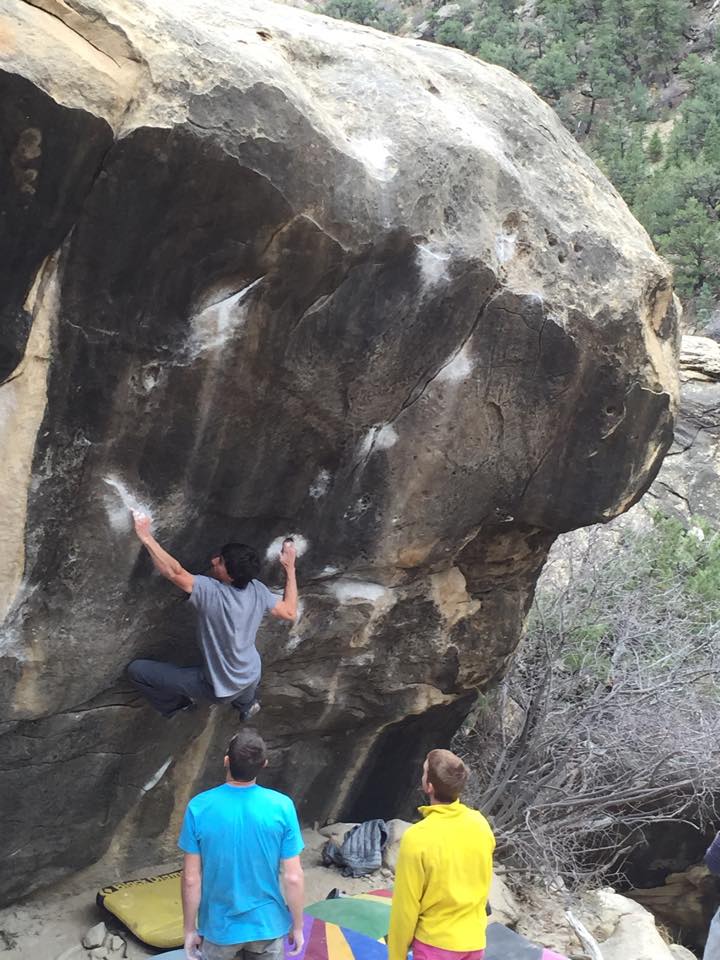
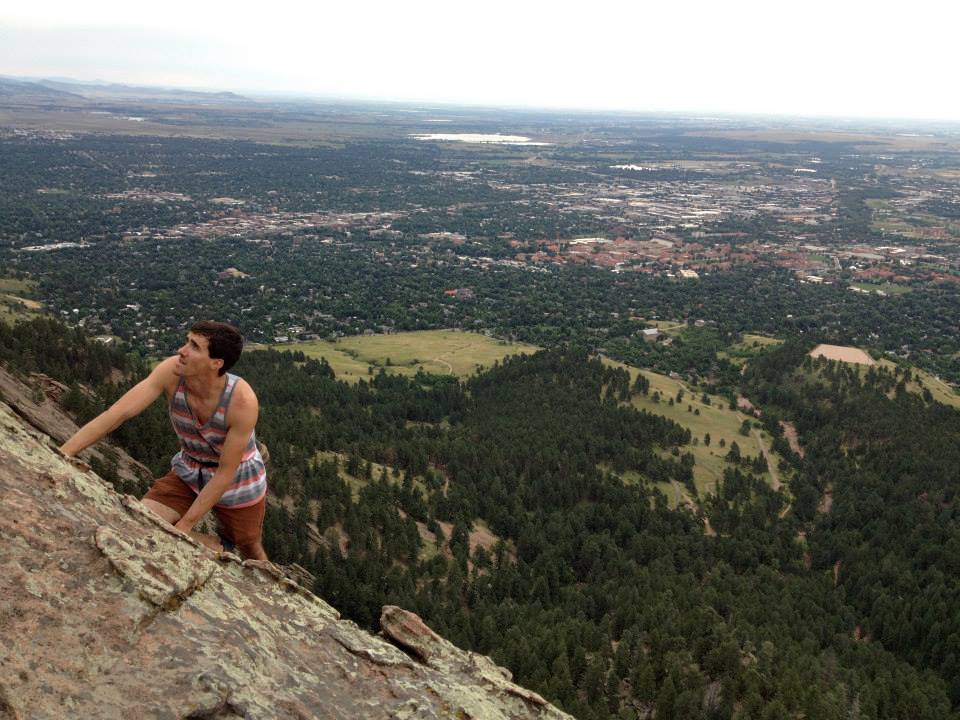
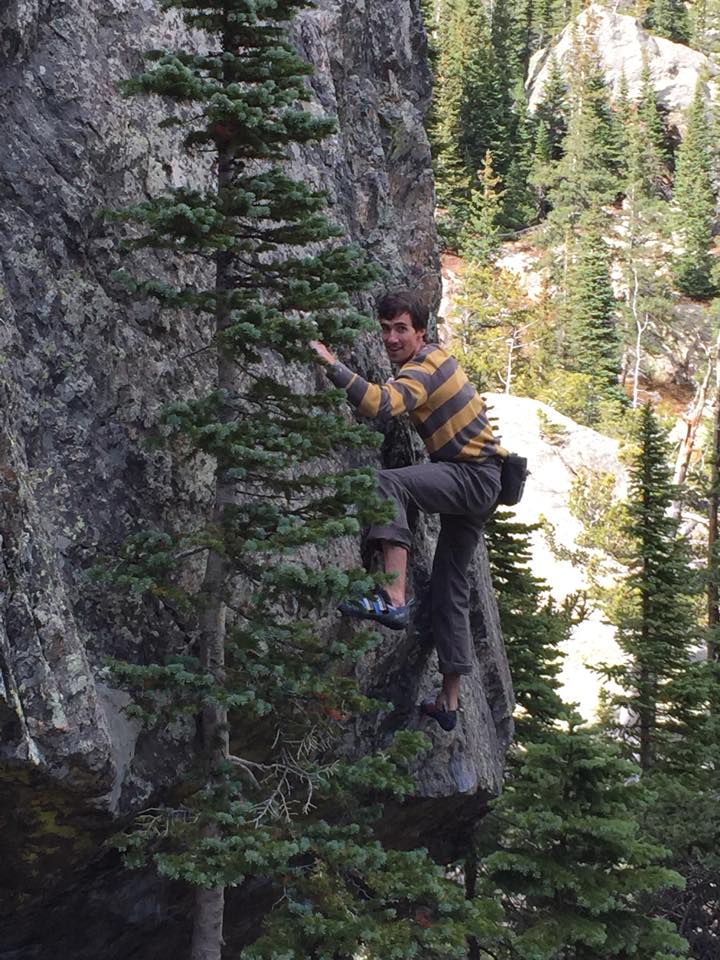
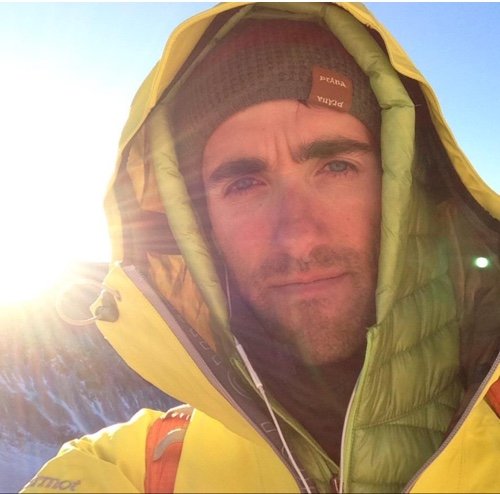
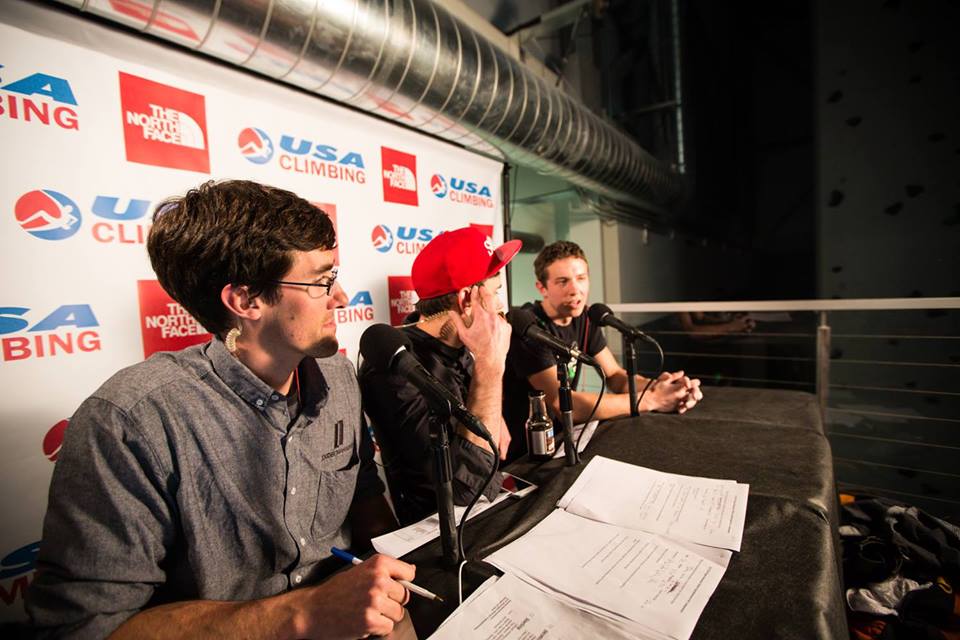
[…] Check out a 2014 Thundercling interview with the Narc here. […]